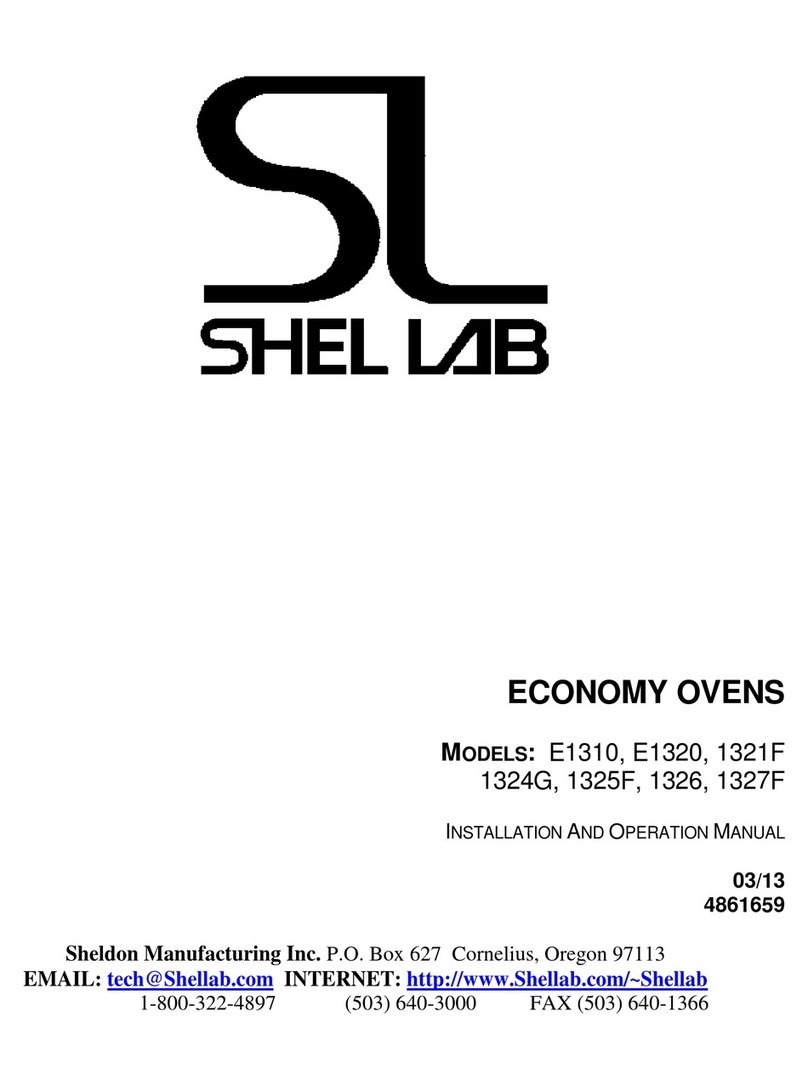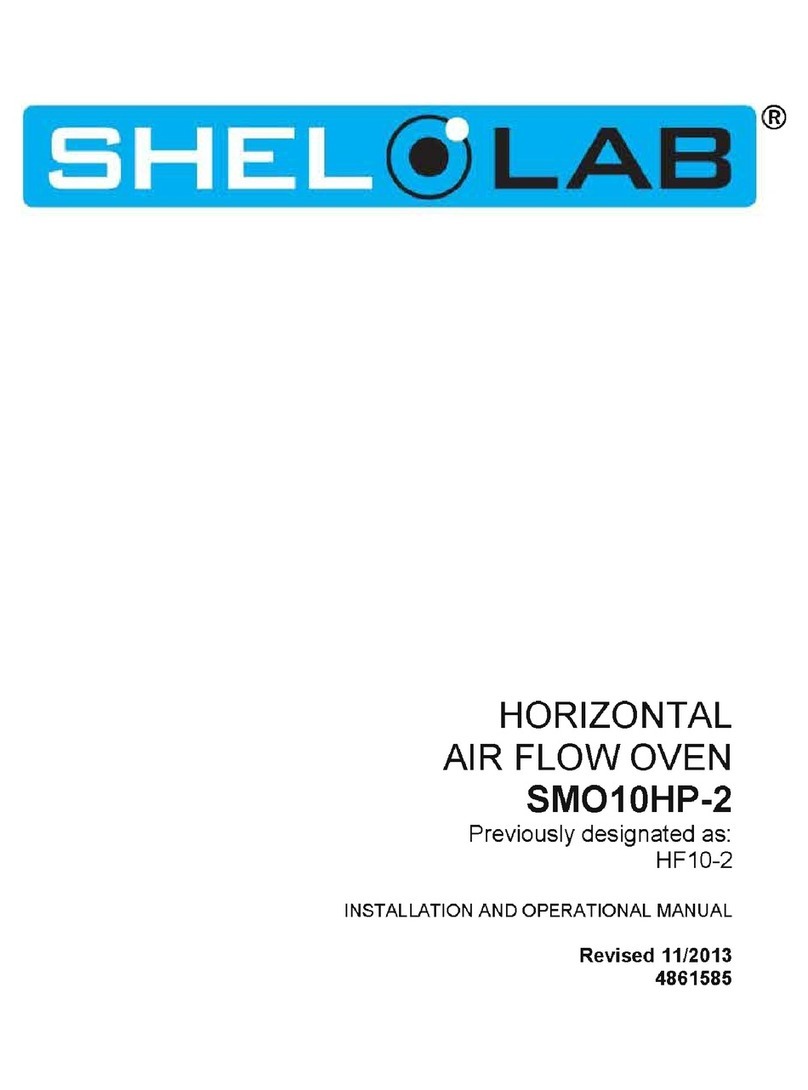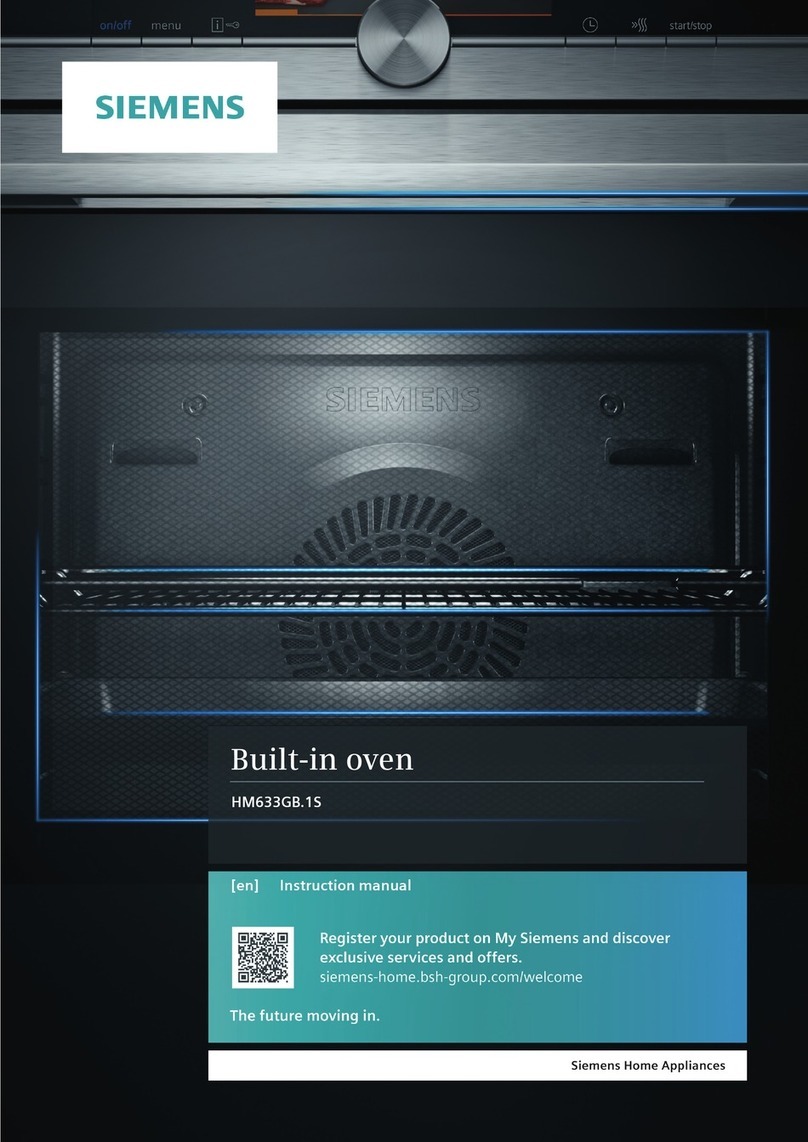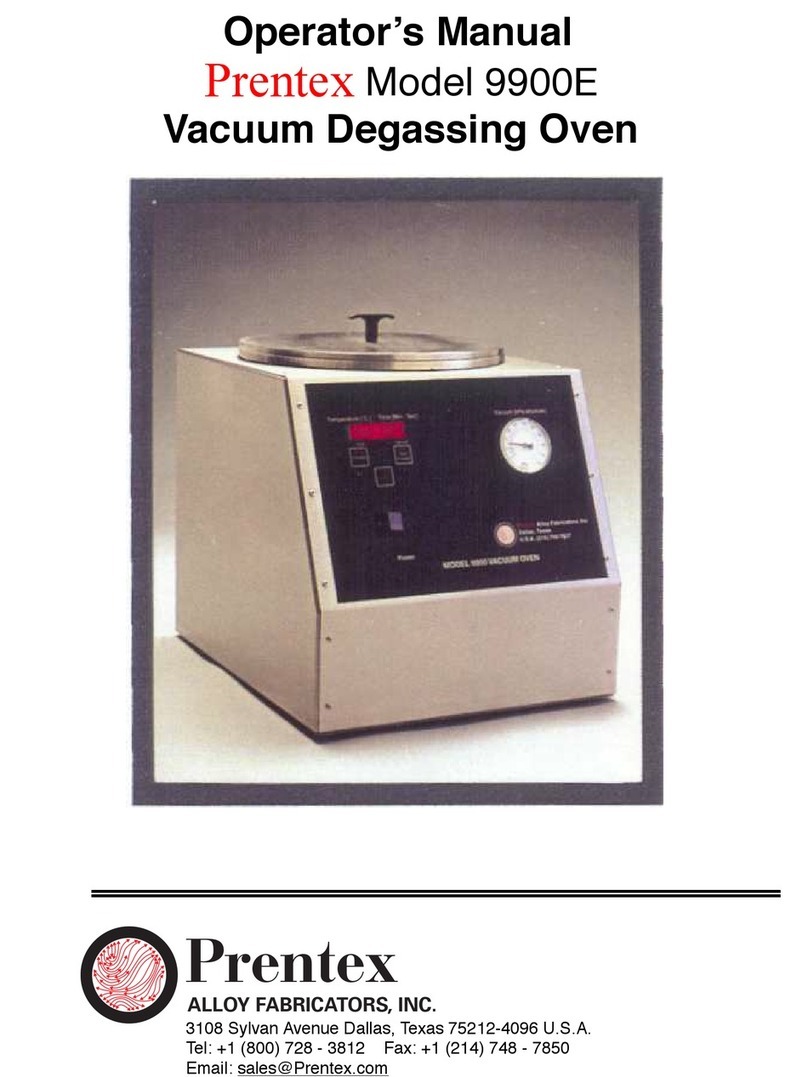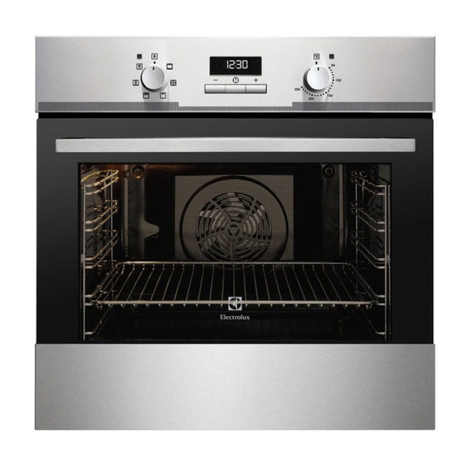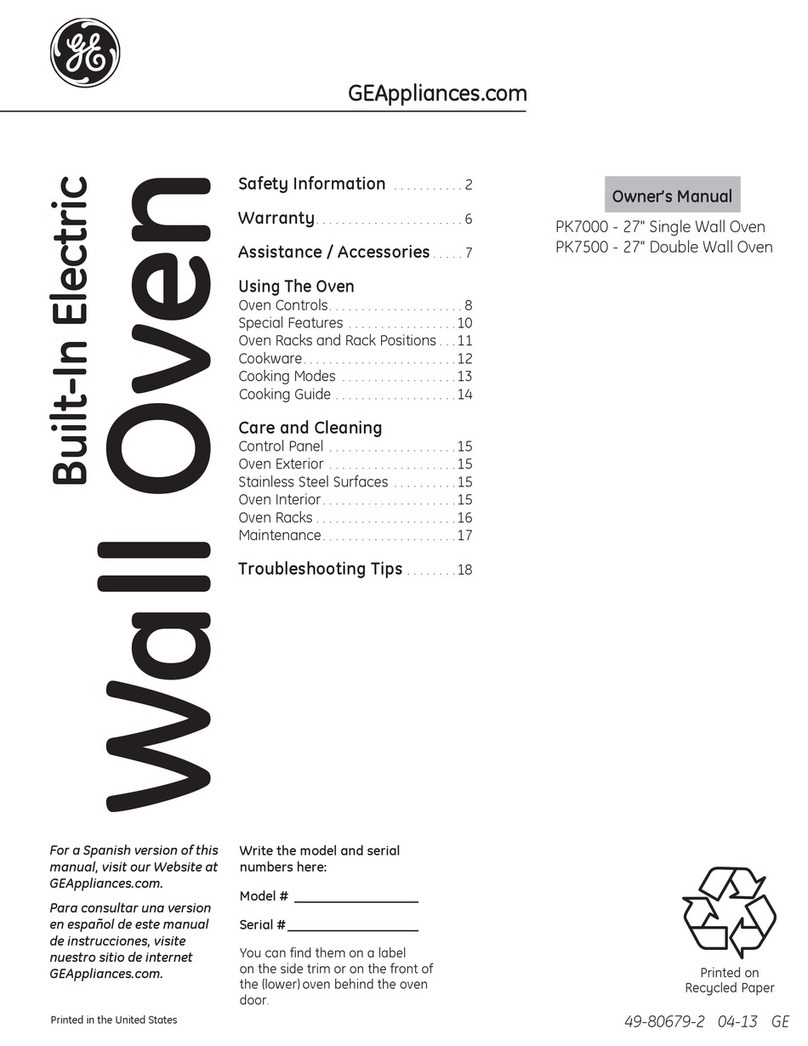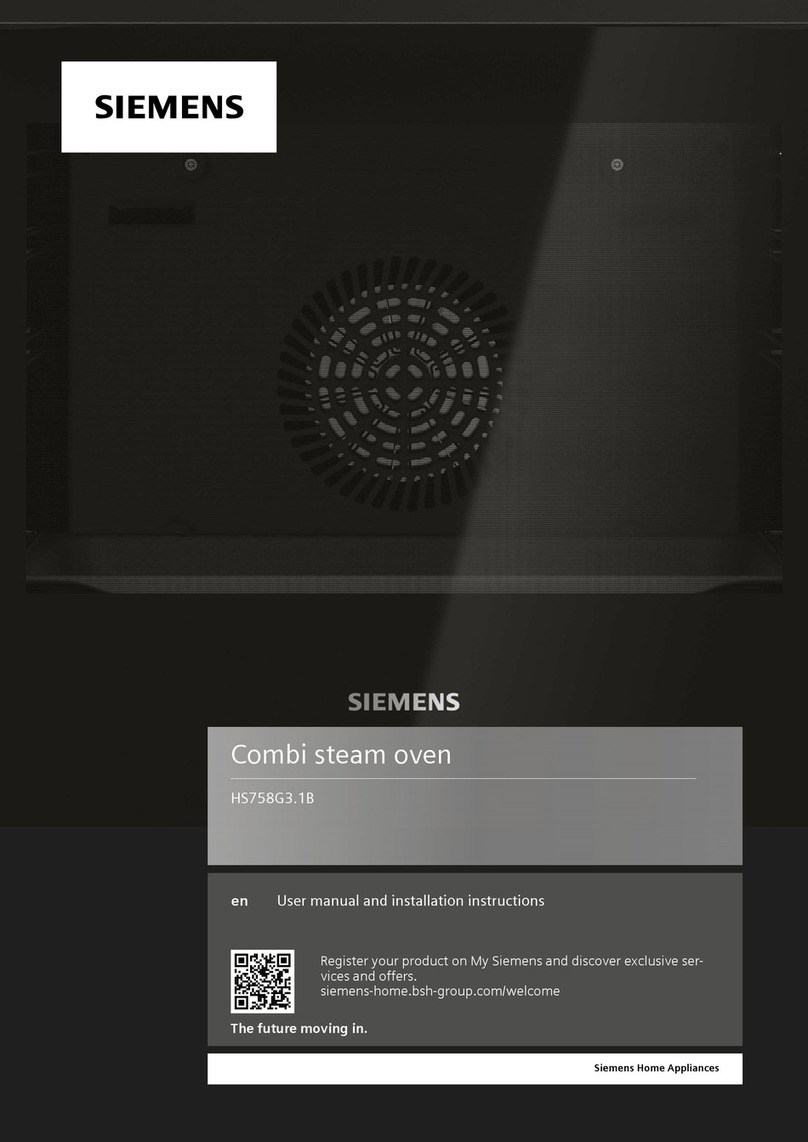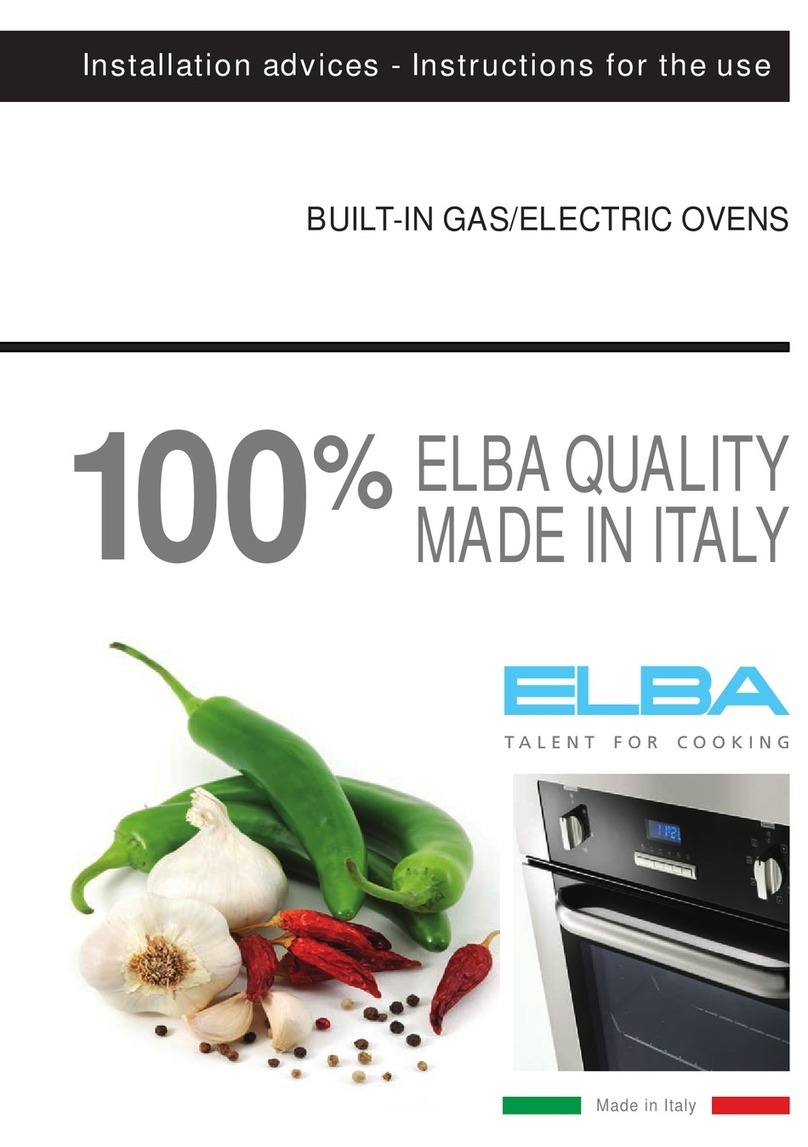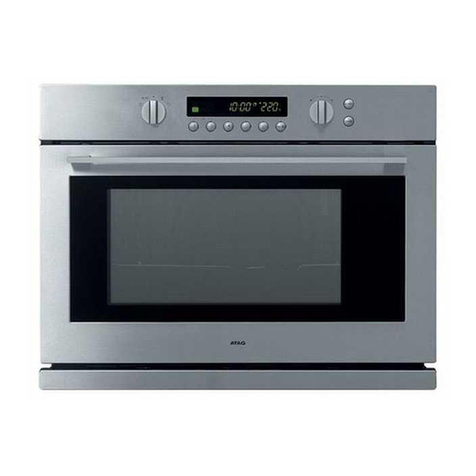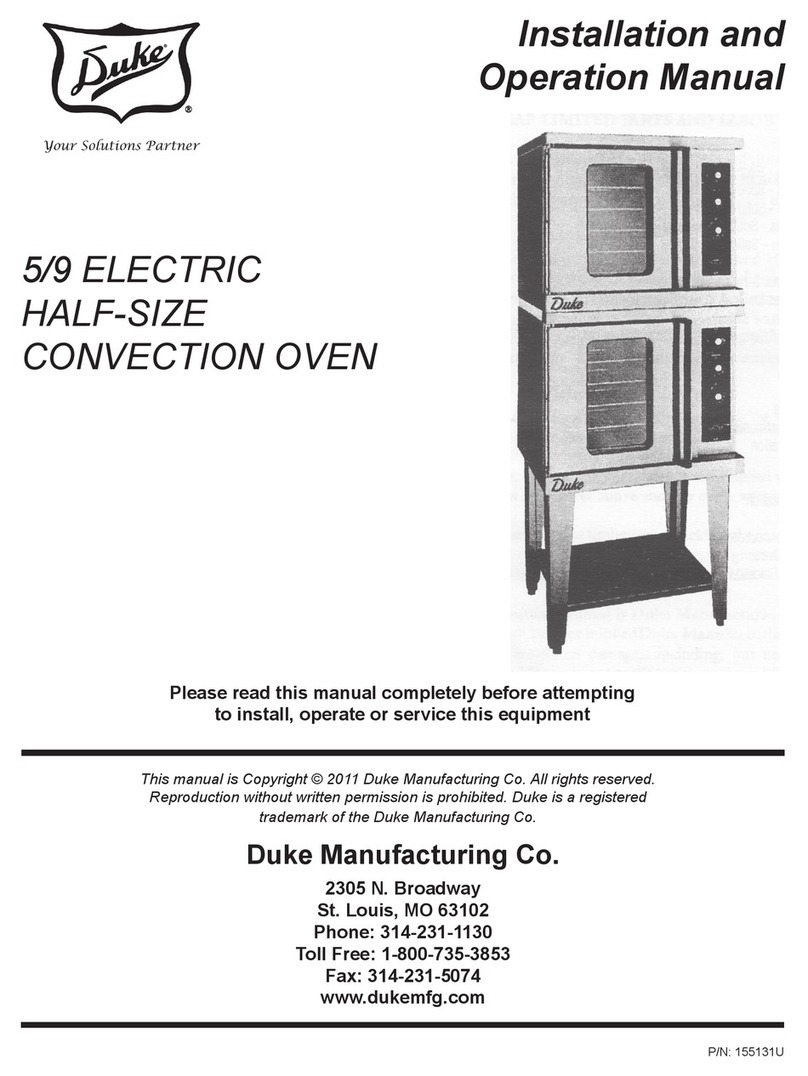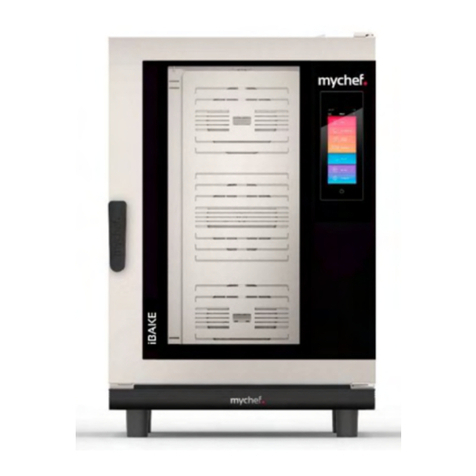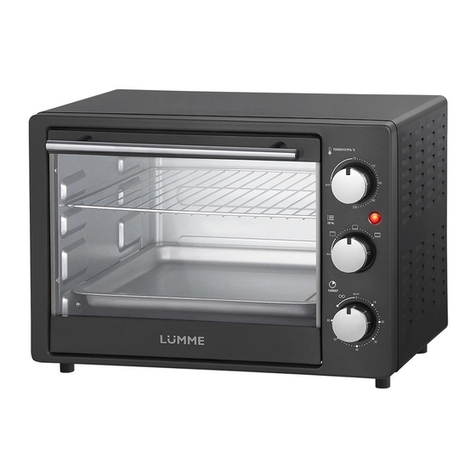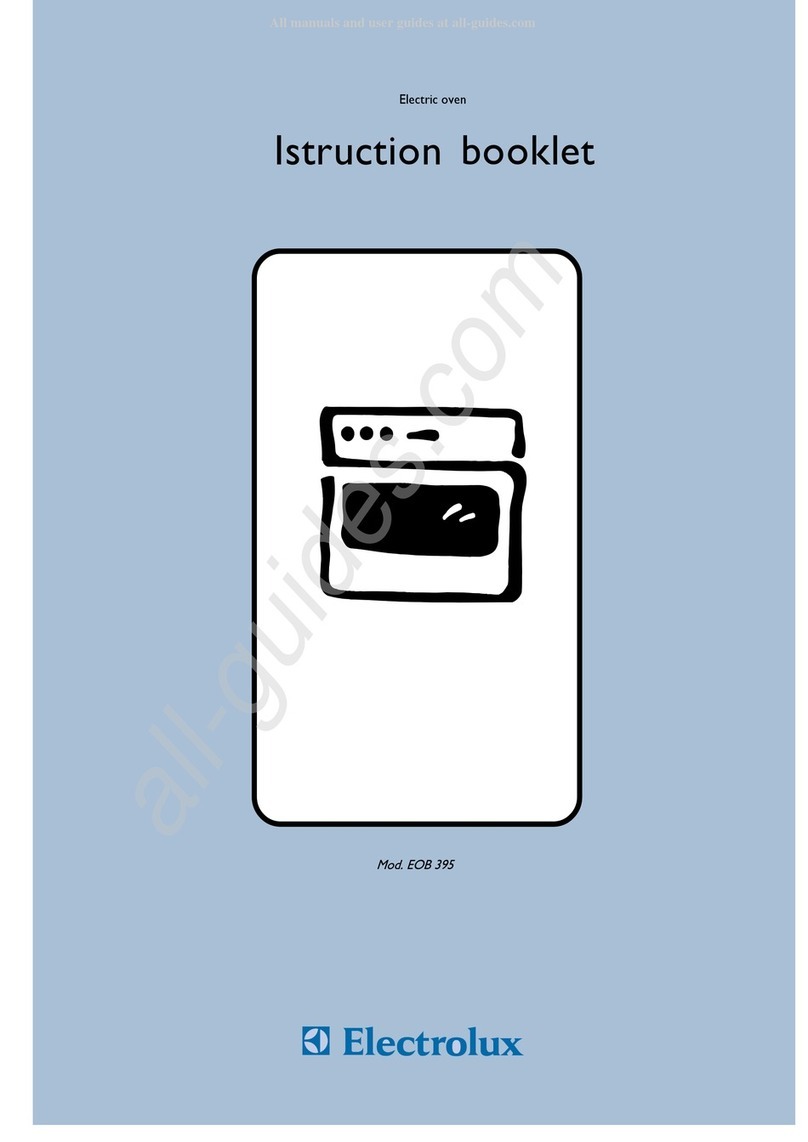shelolab SGO1-2 User manual

Installation - Operation Manual
SGO1-2 SGO3-2 SGO5-2
GRAVITY OVENS 220 – 240 Voltage

2 | Page

3 | Page
SGO Gravity Ovens 220 – 240 Voltage
Part Number (Manual): 4861728
Revision: March 30, 2018
Pictured on Cover: Left to right SGO1-2, SGO3-2, SGO5-2
SLG122-EA, SLG322-EA, SLG522-EA
SHEL LAB is a brand of Sheldon Manufacturing, INC.
Safety Certifications
These units are CUE listed by TÜV SÜD as gravity ovens for professional, industrial, or educational
use where the preparation or testing of materials is done at an ambient air pressure range of 22.14 –
31.3 inHg (75 – 106 kPa) and no flammable, volatile, or combustible materials are being heated.
The units have been tested to the following requirements:
CAN/CSA-22.2 No. 61010-1:2012/U2:2016-04
CAN/CSA-C22.2 No. 61010-2-010:2015
UL 61010-1:2012/R:2016-04
UL 61010-2-010:2015
EN 61010-1:2010
EN 61010-2-010:2014

4 | Page
TABLE OF CONTENTS
INTRODUCTION ........................................................................................................................................................ 5
Read this Manual....................................................................................................................................................................5
Safety Considerations and Requirements ......................................................................................................................5
Contacting Assistance ..........................................................................................................................................................6
Engineering Improvements..................................................................................................................................................6
Reference Sensor Device .................................................................................................................................................... 7
RECEIVING YOUR UNIT ........................................................................................................................................... 9
Inspect the Shipment.............................................................................................................................................................9
Orientation Photos ............................................................................................................................................................... 10
Recording Data Plate Information................................................................................................................................... 14
INSTALLATION .........................................................................................................................................................15
Installation Procedure Checklist ...................................................................................................................................... 15
Required Ambient Conditions........................................................................................................................................... 16
Required Ventilation Clearances..................................................................................................................................... 16
Power Source Requirements .............................................................................................................................................17
Lifting and Handling ............................................................................................................................................................ 18
Leveling................................................................................................................................................................................... 18
Install the Oven ..................................................................................................................................................................... 19
Deionized and Distilled Water.......................................................................................................................................... 19
Installation - Clean and Disinfect..................................................................................................................................... 19
Shelving Installation............................................................................................................................................................ 20
Access Port Stopper ........................................................................................................................................................... 20
GRAPHIC SYMBOLS ................................................................................................................................................21
CONTROL PANEL OVERVIEW .............................................................................................................................. 23
OPERATION.............................................................................................................................................................. 25
Operating Precautions....................................................................................................................................................... 25
Theory of Operation ........................................................................................................................................................... 26
Put the Oven into Operation ............................................................................................................................................ 28
Set the Temperature Set Point........................................................................................................................................ 29
Set the Over Temperature Limit...................................................................................................................................... 30
Setting the Timer .................................................................................................................................................................. 31
Launching a Heating Profile............................................................................................................................................. 33
High Exterior Temperatures ............................................................................................................................................. 34
Drying Racks and other Accessories............................................................................................................................. 34
USER MAINTENANCE............................................................................................................................................. 35
Cleaning and Disinfecting................................................................................................................................................. 35
Gaskets and Chamber Integrity ...................................................................................................................................... 36
Electrical Components....................................................................................................................................................... 36
Calibrate the Temperature Display.................................................................................................................................37
UNIT SPECIFICATIONS ...........................................................................................................................................41
Weight...................................................................................................................................................................................... 41
Dimensions............................................................................................................................................................................. 41
Capacity .................................................................................................................................................................................. 41
Shelf Capacity by Weight.................................................................................................................................................. 42
Temperature ......................................................................................................................................................................... 42
Power...................................................................................................................................................................................... 43
PARTS LIST............................................................................................................................................................... 45

5 | Page
INTRODUCTION
Thank you for purchasing a SHEL LAB oven. We know you have many choices in today’s competitive
marketplace when it comes to constant temperature equipment. We appreciate you choosing ours. We
stand behind our products and will be here if you need us.
READ THIS MANUAL
Failure to follow the guidelines and instructions in this user manual may create a protection
impairment by disabling or interfering with the unit safety features. This can result in injury or death.
Before using the unit, read the manual in its entirety to understand how to install, operate, and
maintain the unit in a safe manner. Keep this manual available for use by all operators. Ensure all
operators are given appropriate training before the unit begins service.
SAFETY CONSIDERATIONS AND REQUIREMENTS
Follow basic safety precautions, including all national laws, regulations, and local ordinances in your
area regarding the use of this unit. If you have any questions about local requirements, please
contact the appropriate agencies.
SOPs
Because of the range of potential applications this unit can be used for, the operator or their
supervisors must draw up a site-specific standard operating procedure (SOP) covering each
application and associated safety guidelines. This SOP must be written and available to all operators
in a language they understand.
Intended Applications and Locations
SGO gravity ovens are engineered for constant temperature forced-air drying, curing, and baking
applications in professional, industrial, and educational environments. The ovens are not intended
for use at hazardous or household locations.
Power
Your unit and its recommended accessories are designed and tested to meet strict safety
requirements.
•The unit is designed to connect to a power source using the specific power cord type
shipped with the unit.
•Always plug the unit power cord into a protective earth grounded electrical outlet
conforming to national and local electrical codes. If the unit is not grounded properly, parts
such as knobs and controls can conduct electricity and cause serious injury.
•Do not bend the power cord excessively, step on it, or place heavy objects on it.
•A damaged cord can be a shock or fire hazard. Never use a power cord if it is damaged or
altered in any way.
•Use only approved accessories. Do not modify system components. Any alterations or
modifications to your unit not explicitly authorized by the manufacturer can be dangerous
and will void your warranty.

6 | Page
INTRODUCTION
CONTACTING ASSISTANCE
Phone hours for Sheldon Technical Support are 6 am – 4:30 pm Pacific Coast Time (west coast of
the United States, UTC -8), Monday through Friday. Please have the following information ready
when calling or emailing Technical Support: the model numberand the serial number (see page 14).
EMAIL: [email protected]
PHONE: 1-800-322-4897 extension 4, or (503) 640-3000
FAX: (503) 640-1366
Sheldon Manufacturing, INC.
P.O. Box 627
Cornelius, OR 97113
ENGINEERING IMPROVEMENTS
Sheldon Manufacturing, Inc. continually improves all of its products. As a result, engineering changes
and improvements are made from time to time. Therefore, some changes, modifications, and
improvements may not be covered in this manual. If your unit’s operating characteristics or
appearance differs from those described in this manual, please contact your SHEL LAB dealer or
customer service representative for assistance.

7 | Page
INTRODUCTION
REFERENCE SENSOR DEVICE
Must be purchased separately
A reference sensor device is required for calibrating the unit temperature display.
Reference devices must meet the following standards:
•Accurate to at least 1°C
The device should be regularly calibrated, preferably by a third party.
Temperature Probes
Use a digital device with wire thermocouple probes that can be introduced into the oven chamber
through the unit access port. Select thermocouples suitable for the application temperature you will be
calibrating at.
Why Probes?
Reference readings taken outside the chamber using wire temperature probes avoid chamber door
openings. Openings disrupt the chamber temperature. Each disruption requires a minimum 1-hour wait
to allow the atmosphere to re-stabilize before continuing.
No Alcohol or Mercury Thermometers
Alcohol thermometers do not have sufficient accuracy to conducti accurate temperature calibrations.
Never place a mercury thermometer in the unit chamber. Always use thermocouple probes.
Temperature
Reference

8 | Page
INTRODUCTION

9 | Page
RECEIVING YOUR UNIT
INSPECT THE SHIPMENT
•When a unit leaves the factory, safe delivery becomes the responsibility of the carrier.
•Damage sustained during transit is not covered by the manufacturing defect warranty.
•Save the shipping carton until you are certain the unit and its accessories function properly.
When you receive your unit, inspect it for concealed loss or damage to its interior and exterior. If you
find any damage to the unit, follow the carrier’s procedure for claiming damage or loss.
1. Carefully inspect the shipping carton for damage.
2. Report any damage to the carrier service that delivered the unit.
3. If the carton is not damaged, open the carton and remove the contents.
4. Inspect the unit for signs of damage. See the orientation depiction on the next page as a
reference.
5. The unit should come with an Installation and Operation Manual.
6. Verify that the correct number of accessory items has been included.
7. A high-temperature access port stopper ships installed in the port located on the back of the
oven. Verify the presence of the stopper.
8. Carefully check all packaging for accessory items before discarding.
Included Accessories
8 Shelf Clips
4 Leveling Feet
US Power Cord EU Power Cord
Shelves
SGO1 SGO3 SGO5

10 | Page
Figure
1: SGO5-2
RECEIVING YOUR UNIT
ORIENTATION PHOTOS
Exhaust Port with Sliding Dampener
Main Temperature and OTL Sensor Probes
Door Latch
Chamber
Door
Handle
Chamber Gasket
Access Port
Oven Chamber
Control Panel

11 | Page
Figure
2: SGO3-2
RECEIVING YOUR UNIT
Exhaust Port with Sliding Dampener
Main Temperature
and OTL Sensor
Probes
Door Latch
Chamber
Door Handle
Control Panel
Chamber Gasket
Access Port
Oven Chamber

12 | Page
Figure
3: SGO1-2
RECEIVING YOUR UNIT
Door Latch
Control Panel
Access Port
Oven Chamber
Exhaust Port with Sliding Dampener
Chamber Gasket
Main Temperature
and OTL Sensor
Probes (Under Shelf)

13 | Page
RECEIVING YOUR UNIT
Figure
4: Unit Back
Exhaust Vent
Fan
Access Port (Stopper Installed)
Power Cord Inlet
(Holds 1st Fuse)
Fuse Holder
(Holds 2nd Fuse)

14 | Page
RECEIVING YOUR UNIT
RECORDING DATA PLATE INFORMATION
The data plate contains the unit model number and serial number. Tech Support will need this
information during any support call. Record it below for future reference.
•The data plate is located on the back of the oven above the power inlet.
Data Plate Information
Model Number
Serial Number

15 | Page
INSTALLATION
INSTALLATION PROCEDURE CHECKLIST
For installing the oven in a new workspace.
Pre-Installation
Check that the required workspace ambient conditions for the unit are
met, page 16.
•Unit dimensions may be found on page 41
Check that the required ventilation and spacing requirements are met,
page 16.
Check that a suitable electrical outlet and power supply is present, page 17.
Installing the oven in a suitable workspace location
Review the lifting and handling instructions, page 18.
Install the unit in its workspace location, page 18.
Make sure the unit is level, page 18.
Set up the oven for use
Clean the unit chamber and shelving if needed, page 19.
Install the shelving in the unit chamber, page 20.
Verify the stopper is installed in the access port on the outside of the oven,
page 20.

16 | Page
INSTALLATION
REQUIRED AMBIENT CONDITIONS
When selecting a location to install the unit, look for sources of heat, cold, and moving air that can affect
the chamber temperature and atmospheric integrity:
•Proximity to other ovens, autoclaves, and any device that produces significant radiant heat
•High-traffic areas
•Direct sunlight
•Heating and cooling ducts or other sources of fast-moving air currents
This unit is intended for use indoors at room temperatures between 15°C and 40°C(59°F and
104°F) and at no greater than 80% Relative Humidity (at 25°C / 77°F). Operating the unit outside of
these conditions may adversely affect its temperature range and stability.
REQUIRED VENTILATION CLEARANCES
These clearances are required for the oven to operate safely and meet its stated temperature
specifications.
•24 inches (610mm) of headspace clearance is required between the exhaust vent and any
overhead cover or partition.
o12 inches (305mm) of vertical headspace clearance suffices if the oven exhaust is
vented from the workspace through a duct or other channeling.
•Do not place objects on top of the oven.
•Allow at least 6 inches (152mm) from the access port and fan vent on the back of the oven
to the nearest wall or partition. Keep the fan unobstructed at all times.
•The chamber access port is located on the back of the oven. Leave sufficient room for easy
access if oven operators will be using the port.
6” (152mm)
6” (152mm)
12” (305mm)
24” (610mm)
24” (610mm)
6” (152mm) Fan
Access Port
12” (305mm) if
ducting is attached.
Door Swing
SGO1-2: 23” (585mm)
SGO3-2: 27” (686mm
SGO5-2: 32” (813mm)

17 | Page
INSTALLATION
POWER SOURCE REQUIREMENTS
When selecting a location for the unit, verify that each of the following requirements is satisfied:
Power Source: The wall power outlet must meet the power requirements listed on the unit data
plate. These units are intended for 220 – 240 VAC 50/60 Hz applications at the following
amperages:
SGO1-2 SGO3-2 SGO5-2
8.0 Amps 10.0 Amps 10.0 Amps
•Supplied voltage must not vary more than 10% from the data plate rating.
Damage to the unit may result if the supplied voltage varies more than 10%.
•The wall power source must be protective earth grounded and single phase.
•Use a separate circuit to prevent loss of the unit due to overloading or circuit failure.
•The recommended wall circuit breakers for these units are 16 amps.
•The wall power source must conform to all national and local electrical codes.
Power Cord:
The unit must be positioned so that all end-users can quickly unplug the unit in the event of an
emergency.
•The unit comes provided with a 250 volt, 10 Amp, 2.5m (8ft) Euro CEE7/7 power cord.
•This unit is also provided with a 250 Volt, 13Amp, 8.2 feet (2.5m), NEMA 6-15P power
cord.
Fuses:
These units ship with two fuses installed in the power cord inlet and in a fuse holder adjacent to the
inlet.
•Both fuses must be installed and intact for the unit to operate.
•Always find and fix the cause of a blown fuse prior to putting the unit back into operation.
•Fuse type
o250V, T10, 5X20mm
Standard Euro
CEE7/7 wall
socket
NEMA 6-15R
wall socket

18 | Page
INSTALLATION
LIFTING AND HANDLING
The unit is heavy. Use appropriate lifting devices that are sufficiently rated for the unit weight. Follow the
guidelines below when lifting the unit:
•Lift the unit only from its bottom surface.
•Doors, handles, and knobs are not adequate for lifting or stabilization.
•Restrain the unit completely while lifting or transporting so it cannot tip.
•Remove all moving parts, such as shelves and trays, and lock doors in the closed position
during transfers to prevent shifting and damage.
LEVELING
Install the 4 leveling feet with the 4 corner holes on the bottom of the unit. The unit must be level and
stable for safe operation.
Note: To prevent damage when moving the unit, turn all 4 leveling feet so that the leg of each foot
sits inside the unit.

19 | Page
INSTALLATION
INSTALL THE OVEN
Place the unit in a workspace location that meets the criteria discussed in the previous entries of the
Installation section.
DEIONIZED AND DISTILLED WATER
Do not use deionized water to clean the unit. Use of deionized water may corrode metal surfaces
and voids the warranty. The manufacturer recommends the use of distilled water in the resistance
range of 50K Ohm/cm to 1M Ohm/cm, or a conductivity range of 20.0 uS/cm to 1.0 uS/cm, for
cleaning.
INSTALLATION -CLEAN AND DISINFECT
Cleaning and disinfecting the unit chamber, shelving components, and ceiling air duct now reduces the
risk of contamination. The chamber and shelving were cleaned and disinfected at the factory, however,
the unit may have been exposed to contaminants during shipping.
•Remove all protective wrappings from shelving components and the ceiling air duct prior to
cleaning.
•See the Cleaning and Disinfecting entry on page 35 for information on how to clean and
disinfect without damaging the unit or its components.

20 | Page
INSTALLATION
SHELVING INSTALLATION
1. Install 4 clips for each shelf in the slots located on the sides of the chamber interior.
a. Squeeze each clip.
b. Insert the top tabs first, then the bottom tabs using a rocking motion.
2. Place the shelf on the clips.
ACCESS PORT STOPPER
Verify the port stopper is installed in the access port on the back of
the unit. The oven will not meet its temperature performance
specifications without the stopper installed.
The stopper must always be installed on the outside of the oven.
Installing the stopper on the inside of the oven risks damaging the
stopper.
The intended use of the port is to introduce sensor probes into the
oven chamber.
Figure
7: Port Stopper in Access Port
Figure 5: Install Clips
Figure
6: Place the Shelf
This manual suits for next models
2
Table of contents
Other shelolab Oven manuals
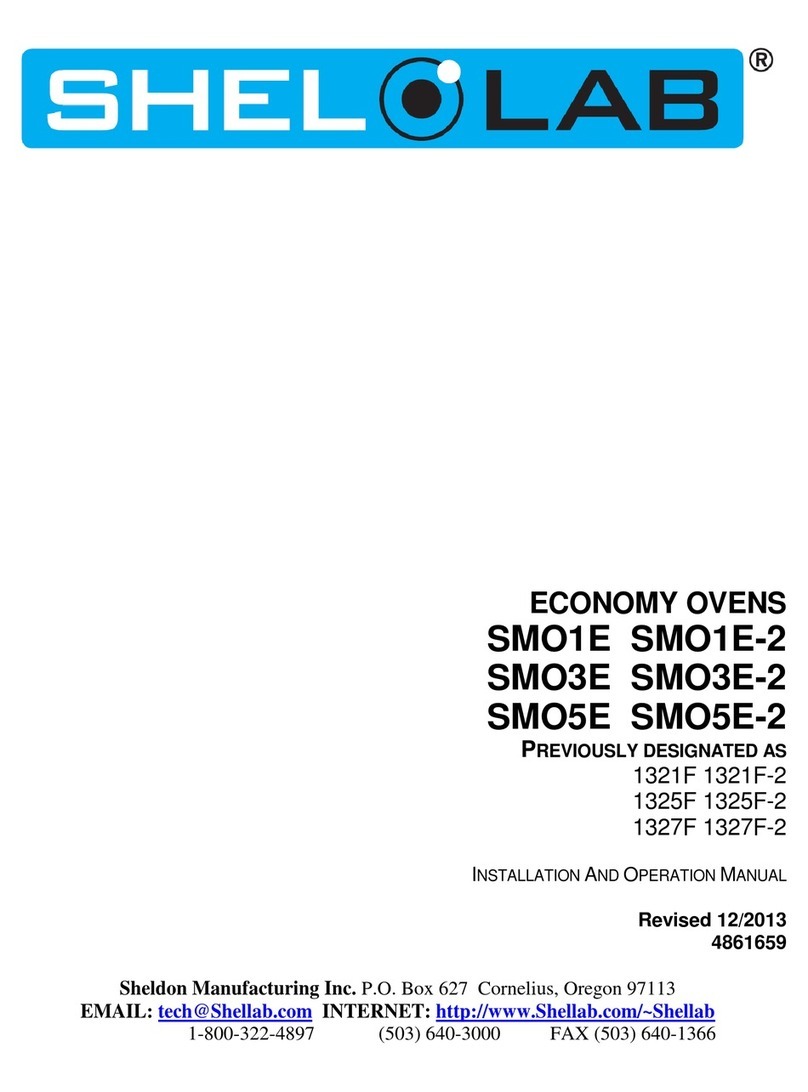
shelolab
shelolab SMO1E User manual
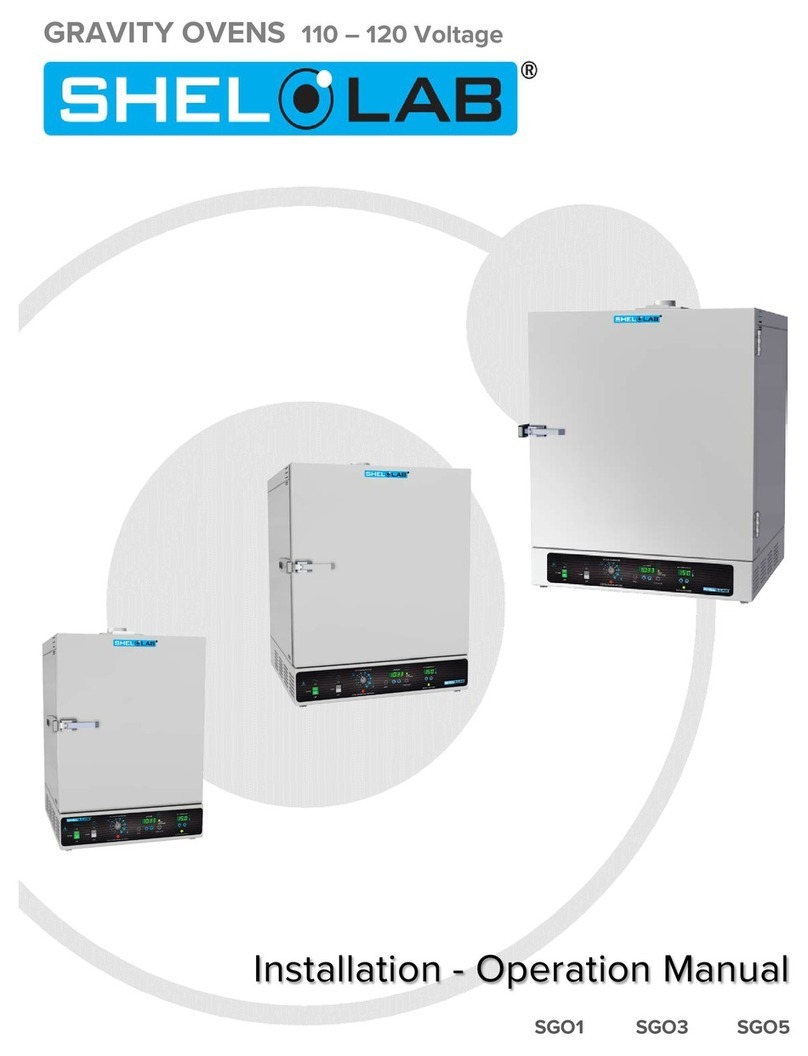
shelolab
shelolab SG02 User manual
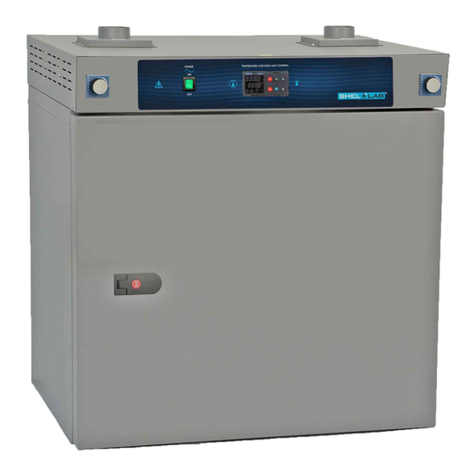
shelolab
shelolab SMO5HP-2 User manual
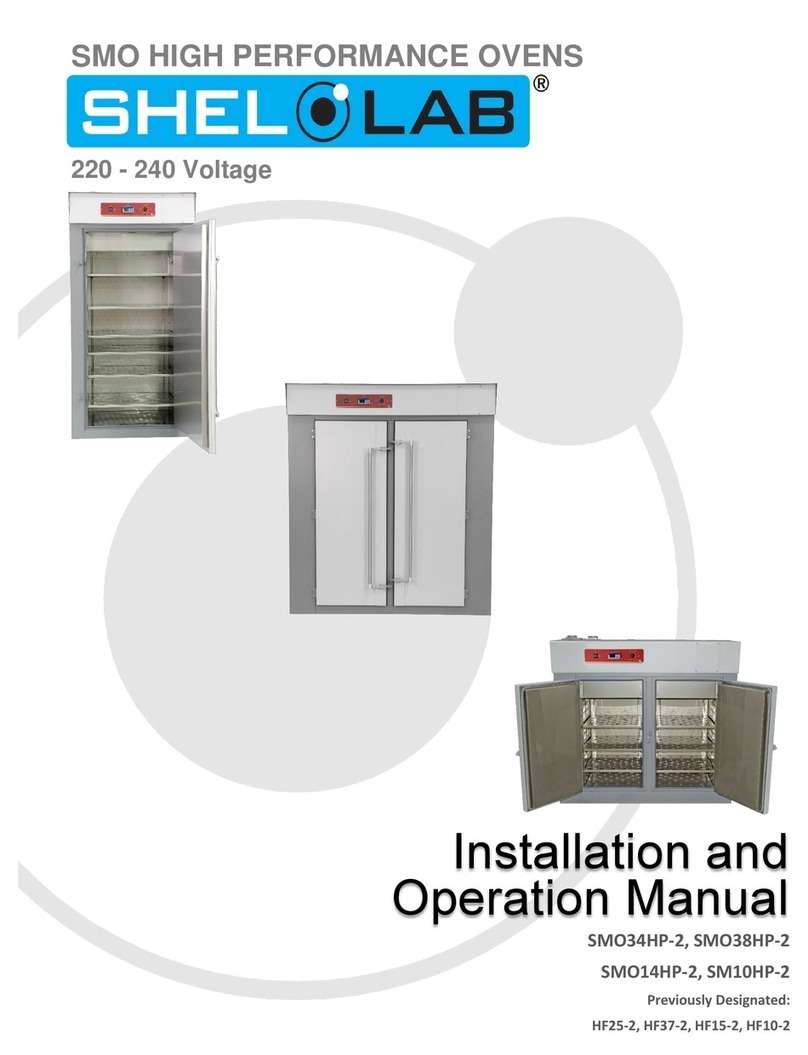
shelolab
shelolab SMO34HP-2 User manual
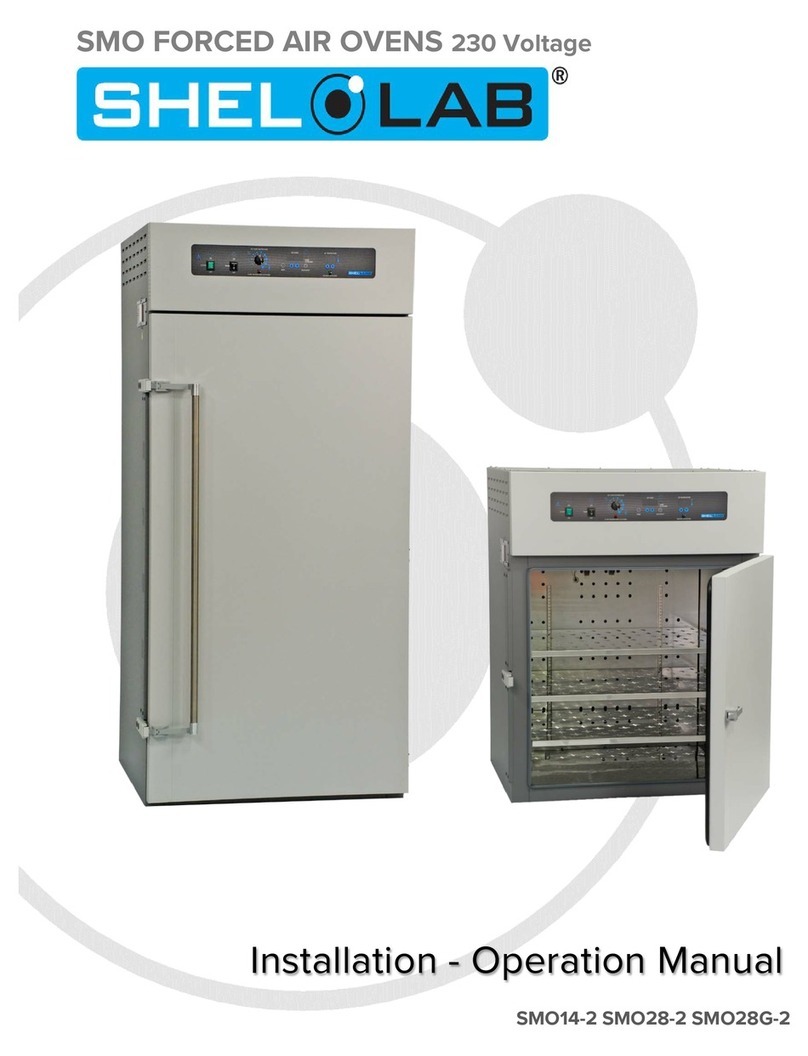
shelolab
shelolab SMO14-2 User manual
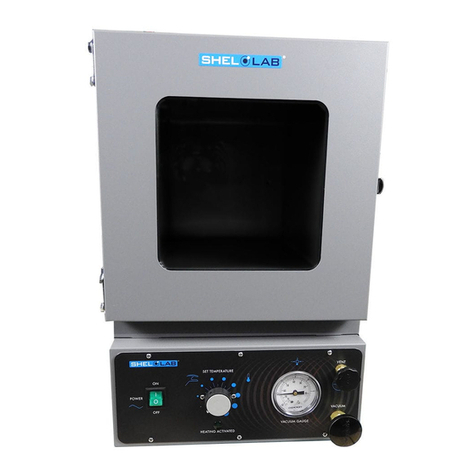
shelolab
shelolab SVAC1E User manual
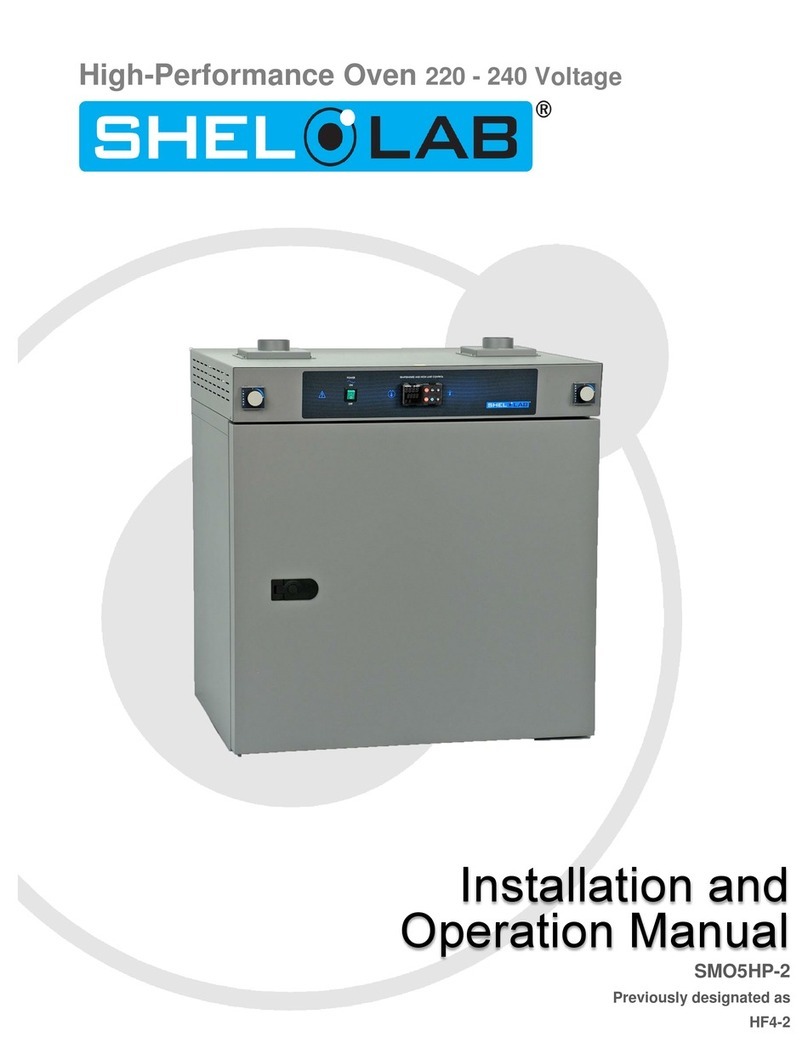
shelolab
shelolab SMO5HP-2 User manual
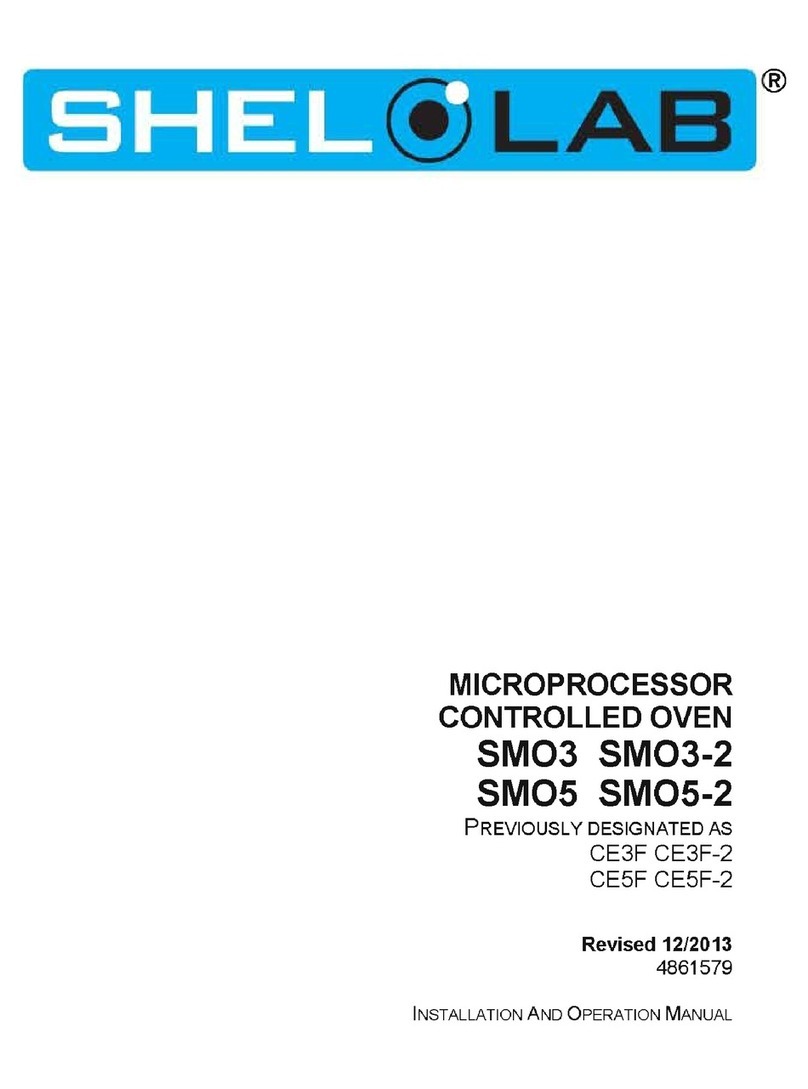
shelolab
shelolab SMO3 User manual
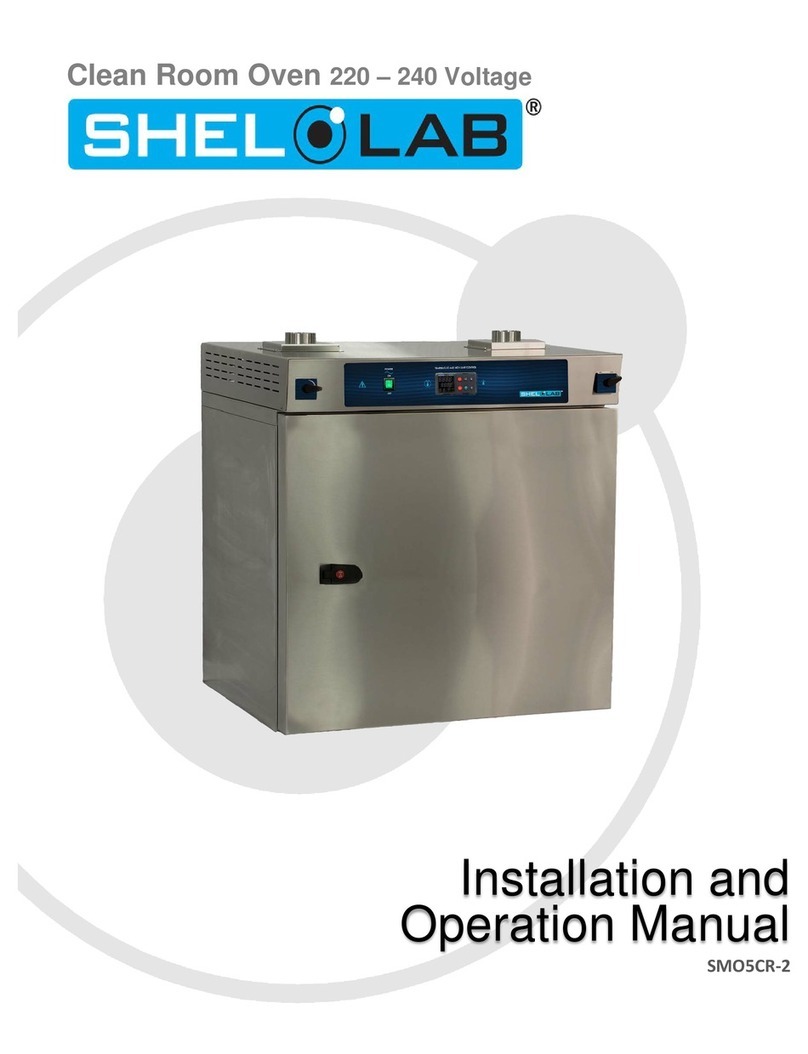
shelolab
shelolab SMO5CR-2 User manual
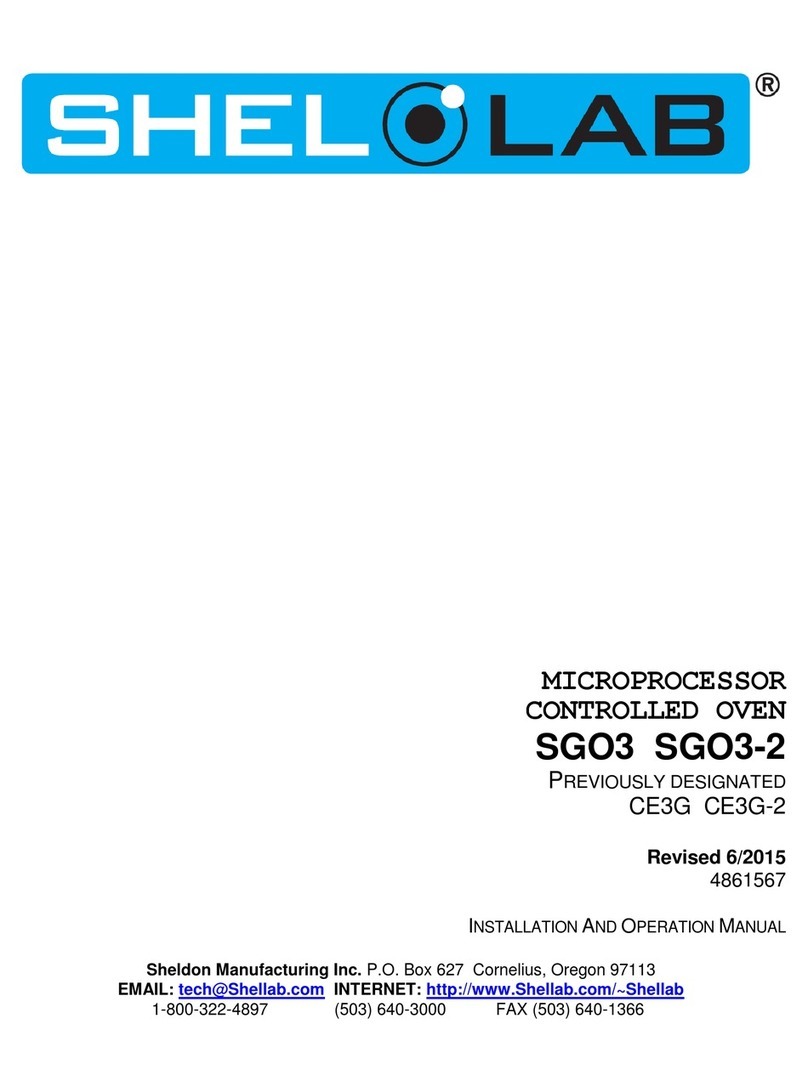
shelolab
shelolab SGO3 User manual


